Unit2 Let’s make a fruit salad Story time教案
文档属性
| 名称 | Unit2 Let’s make a fruit salad Story time教案 | 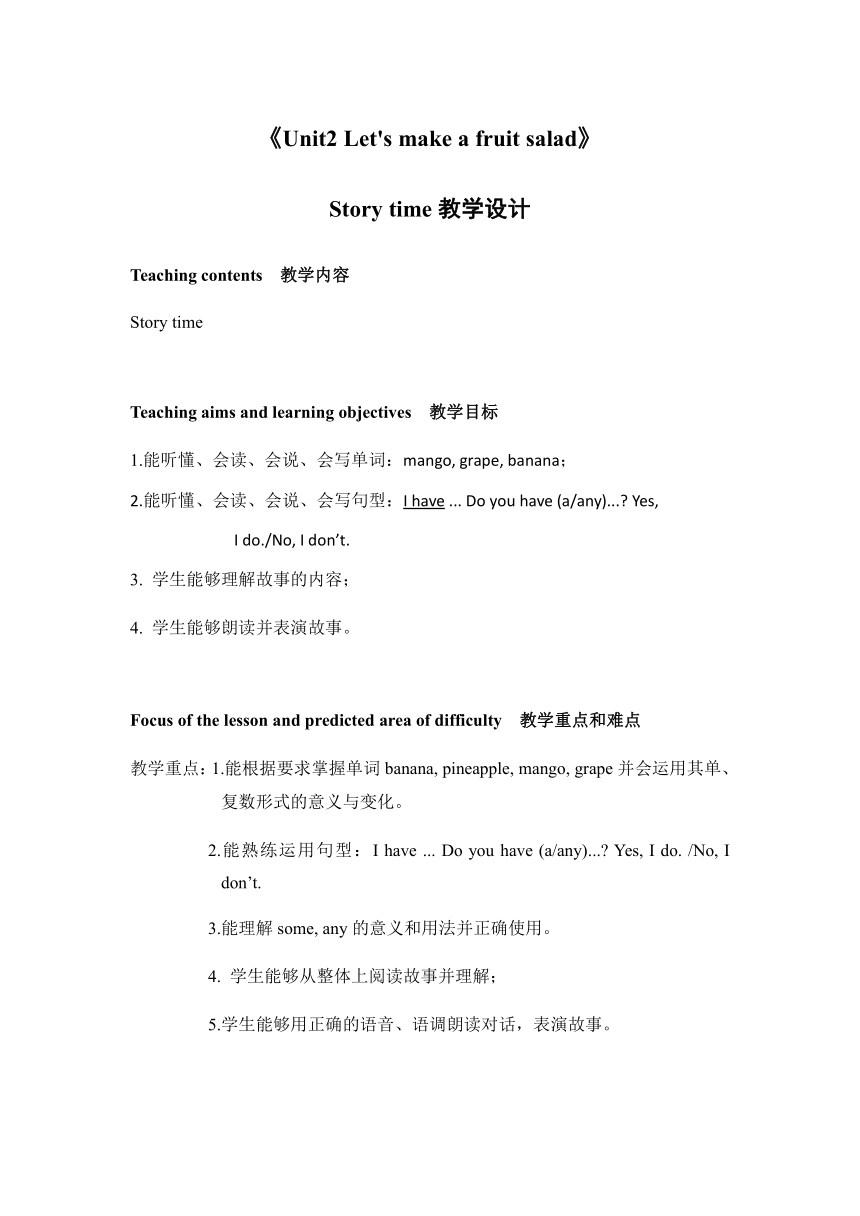 | |
| 格式 | docx | ||
| 文件大小 | 31.3KB | ||
| 资源类型 | 教案 | ||
| 版本资源 | 牛津译林版 | ||
| 科目 | 英语 | ||
| 更新时间 | 2021-10-18 20:55:50 | ||
图片预览

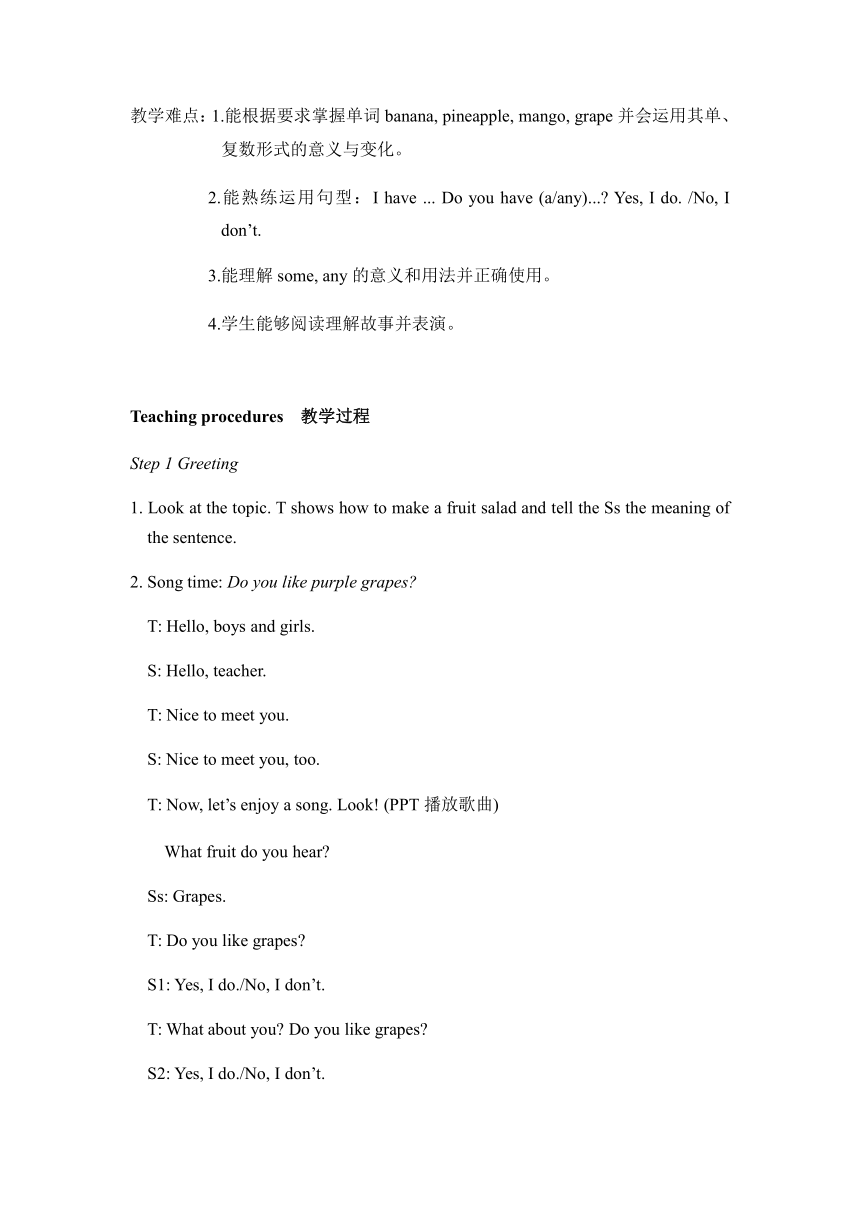
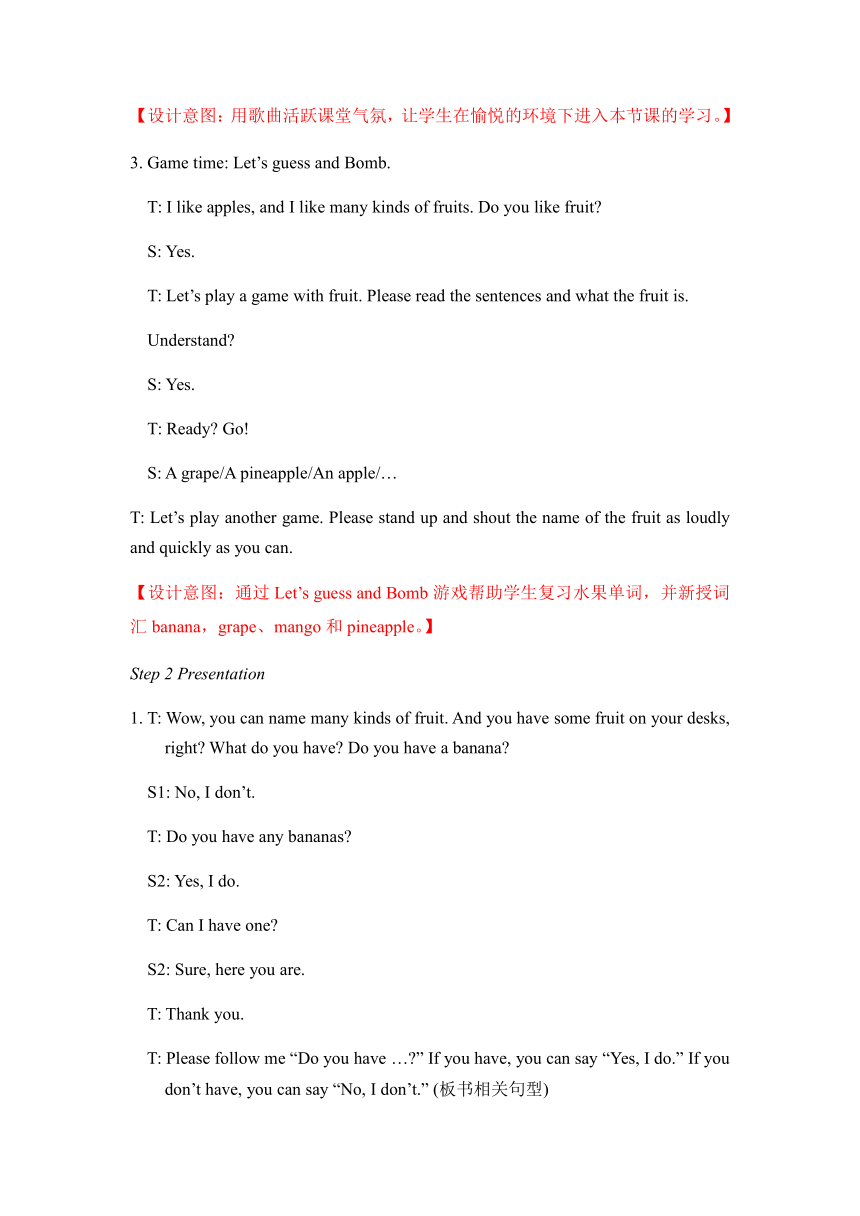
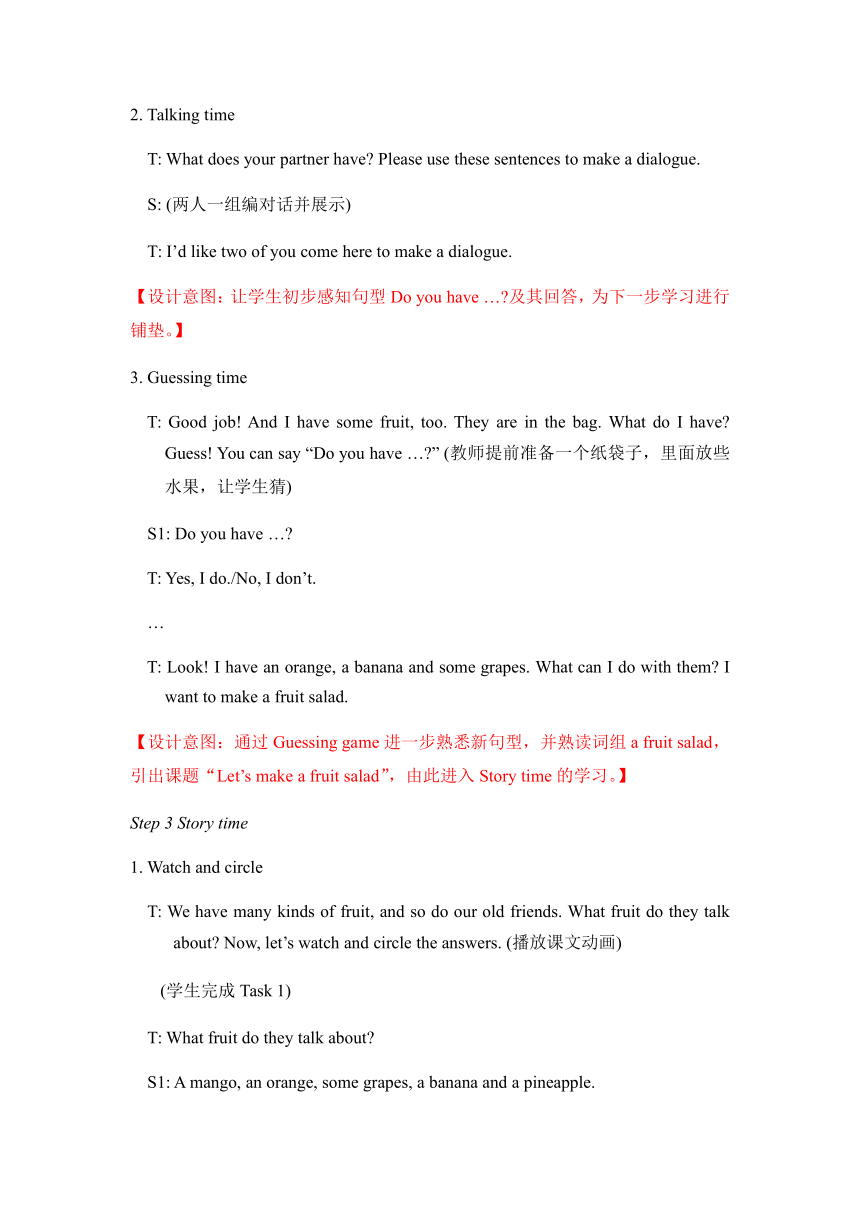
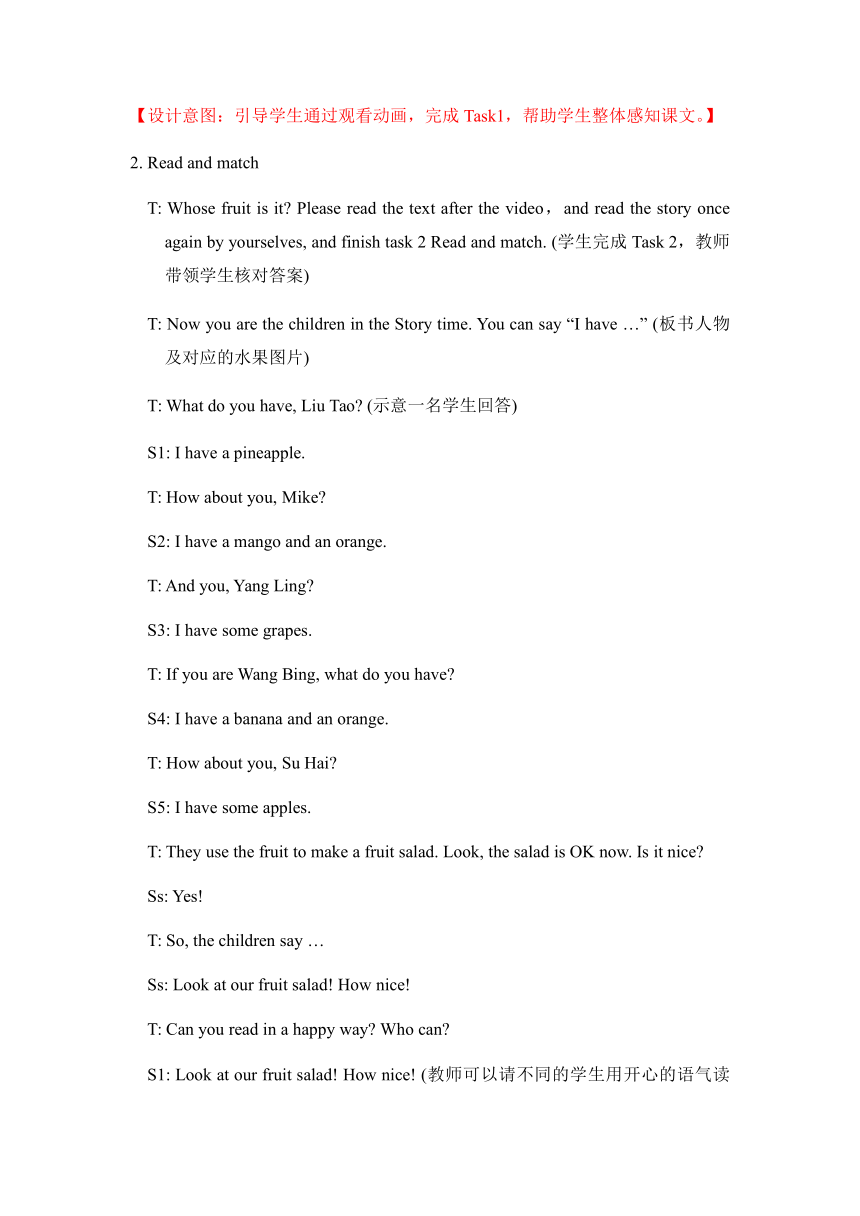
文档简介
《Unit2 Let's make a fruit salad》
Story time教学设计
Teaching contents 教学内容
Story time
Teaching aims and learning objectives 教学目标
1.能听懂、会读、会说、会写单词:mango, grape, banana;
2.能听懂、会读、会说、会写句型:I have ... Do you have (a/any)... Yes,
I do./No, I don’t.
3. 学生能够理解故事的内容;
4. 学生能够朗读并表演故事。
Focus of the lesson and predicted area of difficulty 教学重点和难点
教学重点:1.能根据要求掌握单词banana, pineapple, mango, grape并会运用其单、 复数形式的意义与变化。
2.能熟练运用句型:I have ... Do you have (a/any)... Yes, I do. /No, I don’t.
3.能理解some, any的意义和用法并正确使用。
4. 学生能够从整体上阅读故事并理解;
5.学生能够用正确的语音、语调朗读对话,表演故事。
教学难点:1.能根据要求掌握单词banana, pineapple, mango, grape并会运用其单、 复数形式的意义与变化。
2.能熟练运用句型:I have ... Do you have (a/any)... Yes, I do. /No, I don’t.
3.能理解some, any的意义和用法并正确使用。
4.学生能够阅读理解故事并表演。
Teaching procedures 教学过程
Step 1 Greeting
1. Look at the topic. T shows how to make a fruit salad and tell the Ss the meaning of the sentence.
2. Song time: Do you like purple grapes
T: Hello, boys and girls.
S: Hello, teacher.
T: Nice to meet you.
S: Nice to meet you, too.
T: Now, let’s enjoy a song. Look! (PPT播放歌曲)
What fruit do you hear
Ss: Grapes.
T: Do you like grapes
S1: Yes, I do./No, I don’t.
T: What about you Do you like grapes
S2: Yes, I do./No, I don’t.
【设计意图:用歌曲活跃课堂气氛,让学生在愉悦的环境下进入本节课的学习。】
3. Game time: Let’s guess and Bomb.
T: I like apples, and I like many kinds of fruits. Do you like fruit
S: Yes.
T: Let’s play a game with fruit. Please read the sentences and what the fruit is.
Understand
S: Yes.
T: Ready Go!
S: A grape/A pineapple/An apple/…
T: Let’s play another game. Please stand up and shout the name of the fruit as loudly and quickly as you can.
【设计意图:通过Let’s guess and Bomb游戏帮助学生复习水果单词,并新授词汇banana,grape、mango和pineapple。】
Step 2 Presentation
1. T: Wow, you can name many kinds of fruit. And you have some fruit on your desks, right What do you have Do you have a banana
S1: No, I don’t.
T: Do you have any bananas
S2: Yes, I do.
T: Can I have one
S2: Sure, here you are.
T: Thank you.
T: Please follow me “Do you have … ” If you have, you can say “Yes, I do.” If you don’t have, you can say “No, I don’t.” (板书相关句型)
2. Talking time
T: What does your partner have Please use these sentences to make a dialogue.
S: (两人一组编对话并展示)
T: I’d like two of you come here to make a dialogue.
【设计意图:让学生初步感知句型Do you have … 及其回答,为下一步学习进行铺垫。】
3. Guessing time
T: Good job! And I have some fruit, too. They are in the bag. What do I have Guess! You can say “Do you have … ” (教师提前准备一个纸袋子,里面放些水果,让学生猜)
S1: Do you have …
T: Yes, I do./No, I don’t.
…
T: Look! I have an orange, a banana and some grapes. What can I do with them I want to make a fruit salad.
【设计意图:通过Guessing game进一步熟悉新句型,并熟读词组a fruit salad,引出课题“Let’s make a fruit salad”,由此进入Story time的学习。】
Step 3 Story time
1. Watch and circle
T: We have many kinds of fruit, and so do our old friends. What fruit do they talk about Now, let’s watch and circle the answers. (播放课文动画)
(学生完成Task 1)
T: What fruit do they talk about
S1: A mango, an orange, some grapes, a banana and a pineapple.
【设计意图:引导学生通过观看动画,完成Task1,帮助学生整体感知课文。】
2. Read and match
T: Whose fruit is it Please read the text after the video,and read the story once again by yourselves, and finish task 2 Read and match. (学生完成Task 2,教师带领学生核对答案)
T: Now you are the children in the Story time. You can say “I have …” (板书人物及对应的水果图片)
T: What do you have, Liu Tao (示意一名学生回答)
S1: I have a pineapple.
T: How about you, Mike
S2: I have a mango and an orange.
T: And you, Yang Ling
S3: I have some grapes.
T: If you are Wang Bing, what do you have
S4: I have a banana and an orange.
T: How about you, Su Hai
S5: I have some apples.
T: They use the fruit to make a fruit salad. Look, the salad is OK now. Is it nice
Ss: Yes!
T: So, the children say …
Ss: Look at our fruit salad! How nice!
T: Can you read in a happy way Who can
S1: Look at our fruit salad! How nice! (教师可以请不同的学生用开心的语气读这句话)
【设计意图:引导学生关注课文中的细节信息,并指导学生用正确的语音、语调读句子。】
3. Listen and repeat (听录音跟读课文,鼓励学生模仿语音、语调)
4. Read together (齐读课文)
5. Act Story time (分2大组,再分角色表演课文)
【设计意图:学生可以根据自己的情况,用实物自主选择齐读、分角色朗读或表演课文。鼓励学生用正确的语音、语调,并配上夸张的表情动作完成任务。】
Step 4 Consolidation
Salad show
T: I know you can act the story very well. Now I’ll give you a big challenge. Look here. Can you make a new dialogue
T: Hello! I want to make a fruit salad. Can you help me (选一位同学和教师一起合作示范对话。)
S1: Yes!
T: Bobby, let’s make a fruit salad.
S1: OK.
T: I have a …
S1: Yes, I do.
T: Thanks…
S1: No, I don’t.
T: OK .Look at our fruit salad!
S1: How nice!
T: This time, you need to work in groups of two. Let’s make fruit salads!
Step1:In groups of two, talk about your fruit.
Step2: Make a show in front of the Ss.
T: Excellent, boys and girls. You did a good job today. You can make your own salad after class!
【设计意图:活动要求学生用所学的语言进行对话, 活动对学生的语言提出更高要求,期待通过创新、合作,共同将这节课所学内容以自己的方式演绎出来,课堂气氛再次升至高点。】
Step 5 Picture time
T: I have some nice pictures of fruit salads and let’s take a look!
You can use many kinds of fruits to make fruit salads. You can create trees, children or even a toy train with fruit. Are they nice
S: Yes!
【设计意图:学生在课堂上想象到的水果沙拉比较简单,因此在活动后,让学生欣赏一些漂亮的水果沙拉图片,感受西方饮食文化的魅力。】
Homework 家庭作业
1. Copy the new words and sentences four times.
2.Read the story, and try to make a new one.
3.Make your own salad.
Teaching aids 教学准备(含板书设计)
教学准备:练习纸、各种水果、酸奶、多媒体课件
板书设计: Unit 2 Let’s make a fruit salad!
说课
一、整体情景创设
本节课围绕制作水果沙拉展开话题。学生先了解组内成员准备的水果种类,在学习Story time之后,小组合作对话并设计简单的水果沙拉。这是学生感兴趣的话题,他们乐于参与,乐于交流,乐于分享,真正体会用英语做事情的乐趣。
二、教学流程与设计意图
下面,我们来简要回顾一下教学环节中的活动设计:
Pre-reading 阅读前
在阅读前阶段,我设计了四个前后相连的活动:首先我通过歌曲Do you like purple grapes 引出葡萄,在和学生Free talk时,询问他们喜不喜欢葡萄以及各种水果;接下来通过游戏Guess复习水果单词并教授生词banana、grape、mango和pineapple,游戏中水果的数量从单数变为复数,复习名词复数的表达方式。然后,用句型“Do you have … ”向学生提问,让学生对新句型有初步的感知;之后通过Guessing game让学生用新句型猜一猜我的包里有什么水果;游戏后,告诉学生我要用这些水果制作水果沙拉,然后自然进入Story time的学习。
这样的设计意图在于:1.创设整体情境;2. 激发兴趣和积极性;3. 导入相关话题:fruit salad;4. 渗透句型教学:Do you have … ;5.为Story time的学习做好铺垫。
While-reading 阅读中
阅读前的热身后,我们的学习进入主体部分——阅读中阶段。本阶段中,我设计了以下五个层次递进的活动:
1. Watch and circle 学生带着任务观看动画,整体感知课文;
2. Read and match 学生独立阅读课文并完成任务,关注课文中的细节信息;
(以上两个活动的设计,核心在于“阅读并理解故事”。在理解后,为了更有效地加强语言输入,我又设计了以下朗读与表演的活动。)
3. Listen and repeat 听录音跟读课文,重在培养学生正确的语音、语调,进一步掌握课文中的句子和词汇;
4. Read together 鼓励学生用正确的语音、语调进行整体性朗读,培养学生的语感;
5. Act story time 教师组织学生六人一组,自主选择齐读、分角色朗读或表演课文。这一任务是帮助学生复习、巩固课文的最佳方式,如果学生能将故事内容进行脱稿表演是对自身能力的又一次提高。
Post-reading阅读后
阅读后阶段,我设计了两个活动。首先我鼓励学生利用自带的水果,仿照课文进行对话。在对话中,要注意语言交流。在教师示范过程中,要尽可能多的和同学进行交流,谈论水果,展示水果沙拉。
第一个活动结束后,让学生欣赏一些精致的水果沙拉图片,希望学生能够感受到西方国家在饮食文化上的独特魅力。
最后,跟大家分享一下本节课中的几个“特别关注”:
关注学生对文本的整体感知和细节信息的获取
关注文本的理解,指导学生如何用正确的语音、语调朗读
关注学生在活动中体验用英语做事情的乐趣
Story time教学设计
Teaching contents 教学内容
Story time
Teaching aims and learning objectives 教学目标
1.能听懂、会读、会说、会写单词:mango, grape, banana;
2.能听懂、会读、会说、会写句型:I have ... Do you have (a/any)... Yes,
I do./No, I don’t.
3. 学生能够理解故事的内容;
4. 学生能够朗读并表演故事。
Focus of the lesson and predicted area of difficulty 教学重点和难点
教学重点:1.能根据要求掌握单词banana, pineapple, mango, grape并会运用其单、 复数形式的意义与变化。
2.能熟练运用句型:I have ... Do you have (a/any)... Yes, I do. /No, I don’t.
3.能理解some, any的意义和用法并正确使用。
4. 学生能够从整体上阅读故事并理解;
5.学生能够用正确的语音、语调朗读对话,表演故事。
教学难点:1.能根据要求掌握单词banana, pineapple, mango, grape并会运用其单、 复数形式的意义与变化。
2.能熟练运用句型:I have ... Do you have (a/any)... Yes, I do. /No, I don’t.
3.能理解some, any的意义和用法并正确使用。
4.学生能够阅读理解故事并表演。
Teaching procedures 教学过程
Step 1 Greeting
1. Look at the topic. T shows how to make a fruit salad and tell the Ss the meaning of the sentence.
2. Song time: Do you like purple grapes
T: Hello, boys and girls.
S: Hello, teacher.
T: Nice to meet you.
S: Nice to meet you, too.
T: Now, let’s enjoy a song. Look! (PPT播放歌曲)
What fruit do you hear
Ss: Grapes.
T: Do you like grapes
S1: Yes, I do./No, I don’t.
T: What about you Do you like grapes
S2: Yes, I do./No, I don’t.
【设计意图:用歌曲活跃课堂气氛,让学生在愉悦的环境下进入本节课的学习。】
3. Game time: Let’s guess and Bomb.
T: I like apples, and I like many kinds of fruits. Do you like fruit
S: Yes.
T: Let’s play a game with fruit. Please read the sentences and what the fruit is.
Understand
S: Yes.
T: Ready Go!
S: A grape/A pineapple/An apple/…
T: Let’s play another game. Please stand up and shout the name of the fruit as loudly and quickly as you can.
【设计意图:通过Let’s guess and Bomb游戏帮助学生复习水果单词,并新授词汇banana,grape、mango和pineapple。】
Step 2 Presentation
1. T: Wow, you can name many kinds of fruit. And you have some fruit on your desks, right What do you have Do you have a banana
S1: No, I don’t.
T: Do you have any bananas
S2: Yes, I do.
T: Can I have one
S2: Sure, here you are.
T: Thank you.
T: Please follow me “Do you have … ” If you have, you can say “Yes, I do.” If you don’t have, you can say “No, I don’t.” (板书相关句型)
2. Talking time
T: What does your partner have Please use these sentences to make a dialogue.
S: (两人一组编对话并展示)
T: I’d like two of you come here to make a dialogue.
【设计意图:让学生初步感知句型Do you have … 及其回答,为下一步学习进行铺垫。】
3. Guessing time
T: Good job! And I have some fruit, too. They are in the bag. What do I have Guess! You can say “Do you have … ” (教师提前准备一个纸袋子,里面放些水果,让学生猜)
S1: Do you have …
T: Yes, I do./No, I don’t.
…
T: Look! I have an orange, a banana and some grapes. What can I do with them I want to make a fruit salad.
【设计意图:通过Guessing game进一步熟悉新句型,并熟读词组a fruit salad,引出课题“Let’s make a fruit salad”,由此进入Story time的学习。】
Step 3 Story time
1. Watch and circle
T: We have many kinds of fruit, and so do our old friends. What fruit do they talk about Now, let’s watch and circle the answers. (播放课文动画)
(学生完成Task 1)
T: What fruit do they talk about
S1: A mango, an orange, some grapes, a banana and a pineapple.
【设计意图:引导学生通过观看动画,完成Task1,帮助学生整体感知课文。】
2. Read and match
T: Whose fruit is it Please read the text after the video,and read the story once again by yourselves, and finish task 2 Read and match. (学生完成Task 2,教师带领学生核对答案)
T: Now you are the children in the Story time. You can say “I have …” (板书人物及对应的水果图片)
T: What do you have, Liu Tao (示意一名学生回答)
S1: I have a pineapple.
T: How about you, Mike
S2: I have a mango and an orange.
T: And you, Yang Ling
S3: I have some grapes.
T: If you are Wang Bing, what do you have
S4: I have a banana and an orange.
T: How about you, Su Hai
S5: I have some apples.
T: They use the fruit to make a fruit salad. Look, the salad is OK now. Is it nice
Ss: Yes!
T: So, the children say …
Ss: Look at our fruit salad! How nice!
T: Can you read in a happy way Who can
S1: Look at our fruit salad! How nice! (教师可以请不同的学生用开心的语气读这句话)
【设计意图:引导学生关注课文中的细节信息,并指导学生用正确的语音、语调读句子。】
3. Listen and repeat (听录音跟读课文,鼓励学生模仿语音、语调)
4. Read together (齐读课文)
5. Act Story time (分2大组,再分角色表演课文)
【设计意图:学生可以根据自己的情况,用实物自主选择齐读、分角色朗读或表演课文。鼓励学生用正确的语音、语调,并配上夸张的表情动作完成任务。】
Step 4 Consolidation
Salad show
T: I know you can act the story very well. Now I’ll give you a big challenge. Look here. Can you make a new dialogue
T: Hello! I want to make a fruit salad. Can you help me (选一位同学和教师一起合作示范对话。)
S1: Yes!
T: Bobby, let’s make a fruit salad.
S1: OK.
T: I have a …
S1: Yes, I do.
T: Thanks…
S1: No, I don’t.
T: OK .Look at our fruit salad!
S1: How nice!
T: This time, you need to work in groups of two. Let’s make fruit salads!
Step1:In groups of two, talk about your fruit.
Step2: Make a show in front of the Ss.
T: Excellent, boys and girls. You did a good job today. You can make your own salad after class!
【设计意图:活动要求学生用所学的语言进行对话, 活动对学生的语言提出更高要求,期待通过创新、合作,共同将这节课所学内容以自己的方式演绎出来,课堂气氛再次升至高点。】
Step 5 Picture time
T: I have some nice pictures of fruit salads and let’s take a look!
You can use many kinds of fruits to make fruit salads. You can create trees, children or even a toy train with fruit. Are they nice
S: Yes!
【设计意图:学生在课堂上想象到的水果沙拉比较简单,因此在活动后,让学生欣赏一些漂亮的水果沙拉图片,感受西方饮食文化的魅力。】
Homework 家庭作业
1. Copy the new words and sentences four times.
2.Read the story, and try to make a new one.
3.Make your own salad.
Teaching aids 教学准备(含板书设计)
教学准备:练习纸、各种水果、酸奶、多媒体课件
板书设计: Unit 2 Let’s make a fruit salad!
说课
一、整体情景创设
本节课围绕制作水果沙拉展开话题。学生先了解组内成员准备的水果种类,在学习Story time之后,小组合作对话并设计简单的水果沙拉。这是学生感兴趣的话题,他们乐于参与,乐于交流,乐于分享,真正体会用英语做事情的乐趣。
二、教学流程与设计意图
下面,我们来简要回顾一下教学环节中的活动设计:
Pre-reading 阅读前
在阅读前阶段,我设计了四个前后相连的活动:首先我通过歌曲Do you like purple grapes 引出葡萄,在和学生Free talk时,询问他们喜不喜欢葡萄以及各种水果;接下来通过游戏Guess复习水果单词并教授生词banana、grape、mango和pineapple,游戏中水果的数量从单数变为复数,复习名词复数的表达方式。然后,用句型“Do you have … ”向学生提问,让学生对新句型有初步的感知;之后通过Guessing game让学生用新句型猜一猜我的包里有什么水果;游戏后,告诉学生我要用这些水果制作水果沙拉,然后自然进入Story time的学习。
这样的设计意图在于:1.创设整体情境;2. 激发兴趣和积极性;3. 导入相关话题:fruit salad;4. 渗透句型教学:Do you have … ;5.为Story time的学习做好铺垫。
While-reading 阅读中
阅读前的热身后,我们的学习进入主体部分——阅读中阶段。本阶段中,我设计了以下五个层次递进的活动:
1. Watch and circle 学生带着任务观看动画,整体感知课文;
2. Read and match 学生独立阅读课文并完成任务,关注课文中的细节信息;
(以上两个活动的设计,核心在于“阅读并理解故事”。在理解后,为了更有效地加强语言输入,我又设计了以下朗读与表演的活动。)
3. Listen and repeat 听录音跟读课文,重在培养学生正确的语音、语调,进一步掌握课文中的句子和词汇;
4. Read together 鼓励学生用正确的语音、语调进行整体性朗读,培养学生的语感;
5. Act story time 教师组织学生六人一组,自主选择齐读、分角色朗读或表演课文。这一任务是帮助学生复习、巩固课文的最佳方式,如果学生能将故事内容进行脱稿表演是对自身能力的又一次提高。
Post-reading阅读后
阅读后阶段,我设计了两个活动。首先我鼓励学生利用自带的水果,仿照课文进行对话。在对话中,要注意语言交流。在教师示范过程中,要尽可能多的和同学进行交流,谈论水果,展示水果沙拉。
第一个活动结束后,让学生欣赏一些精致的水果沙拉图片,希望学生能够感受到西方国家在饮食文化上的独特魅力。
最后,跟大家分享一下本节课中的几个“特别关注”:
关注学生对文本的整体感知和细节信息的获取
关注文本的理解,指导学生如何用正确的语音、语调朗读
关注学生在活动中体验用英语做事情的乐趣
